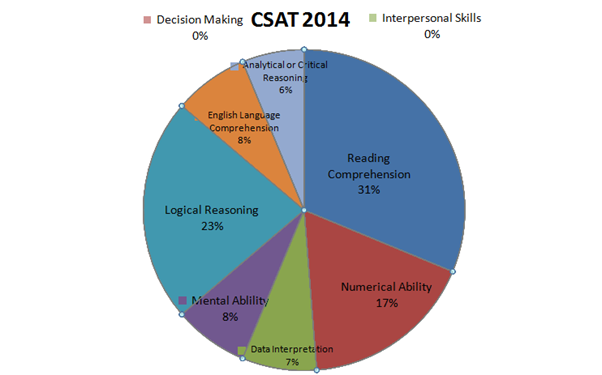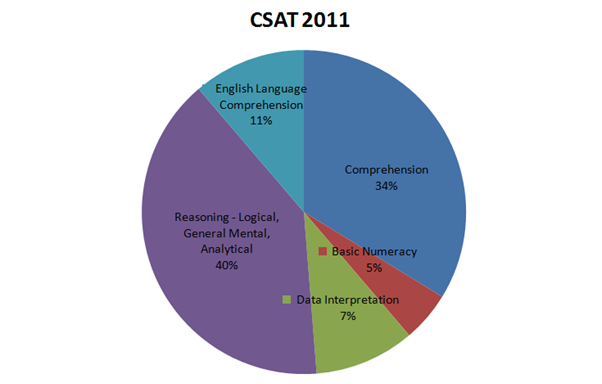Paper II CSAT officially known as General Studies Paper- 2 contains totally 80 questions – each being 2.5 marks. It is most loved as well as hated section of IAS exam by different groups for different reasons.
While people who have a “strong” mathematical/English analytical background might find it a cakewalk .People who perceive the lack of same almost have a phobia of this paper.
We have tried to deconstruct some of the myths and provide insights into various aspects of the “dreaded/loved” paper. CSAT paper II tests your basic language skills, logical abilities and common sense at Class X/XII level.
There is provision for negative marking (1/3rd of total marks allotted to each question for each wrong answer).
The exam duration is of 2 hours – held from 2.30-4.30 PM in the second session.
In this section we have breakdown the syllabus and touched upon only the basic elements.
For a detailed analysis please click on the detailed analysis section.
It is followed up by pattern analysis of 2011-14 so that you efforts are in tab with the latest trends.
Index
- Syllabus – with sub-categories
- Pattern Analysis – with weightage of each section since CSAT 2011
Syllabus
Note: The text in bold is the syllabus as verbatim mentioned in the CSAT notification. The sub-categories have been elaborated for your information & understanding. Examples from each sub-category will be given in the “Detailed Strategy” Section.
It includes:
Comprehension
- English/Hindi Paragraph Comprehension
Interpersonal skills including communication skills
- Analogies
- Critical Reasoning
Logical Reasoning and Analytical ability
- Logical Reasoning based on Arrangement
- Logical Reasoning based on Ranking
- Team Formations
- Quantitative Reasoning
- Sequences and Series
- Blood Relation
- Direction Test
- Puzzle Test
Decision-making and problem-solving
- Hypothetical questions based on ethical dilemmas
- Decoding facts logically into answers
General mental ability
- Syllogisms
- Logical Deductions
- Statement and Conclusions
- Statement and Assumptions
- Assertion and Reason
- Statement Courses of Action
- Set Theory and Venn Diagrams
- Network Diagrams
- Verbal Reasoning Based on Binary Logic
Basic numeracy (numbers and their relations, orders of magnitude, etc.) (Class X level),
- Number System and Number Series
- HCF and LCM of Numbers
- Fraction
- Simplification
- Percentage
- Average
- Ratio and Proportion
- Partnership and Share
- Mixtures
- Chain Rule
- Time, Work and Wages
- Pipes and Cisterns
- Profit, Loss and Discount
- Simple Interest
- Time and Distance
- Trains
- Clocks
Data interpretation (charts, graphs, tables, data sufficiency etc. – Class X level)
Pattern Analysis




Following inferences can be derived from the data above and from the experience of IASbaba:
Comprehension & Reasoning (General, Logical, Analytical) has carried very high weightage over all the years. And is expected to remain so. Hence, these two areas require high focus as they account for about 60-70% of total marks. Moreover,
-
Comprehension level is becoming moderate level (from easy) over the years. Plus UPSC is increasing the length of comprehension.
-
Reasoning questions’ level too has increased (except 2013 when it was easy). Practicing questions tougher than UPSC CSAT level will make the exam day easy for you.
Those who are weak in Mathematics need not worry as the weightage has been generally low – around 7-8% except in 2013. Even if you are not thorough with every topic in basic numeracy, you will sail through. So, you need not focus too much on maths. Focus more on comprehension and reasoning.
The weightage of Data Interpretation (DI) has remained constant throughout the years (except 2011 when it was not asked). And the level of DI is very basic. So, you need not practice elaborate DIs like the ones asked in CAT.
The lesson that you need to take from here is that focussing on core areas like Comprehension and reasoning will give you a better score, rather than breaking your head studying & practicing everything under the sky. Practice the kind of questions that are being repeated often in UPSC like critical reasoning, team formations, arrangements, rankings etc. Putting your energy in the right channels will save you substantial time (for studying GS).
To start the preparation, refer to the “Basic and Detailed Strategy Section” below.






